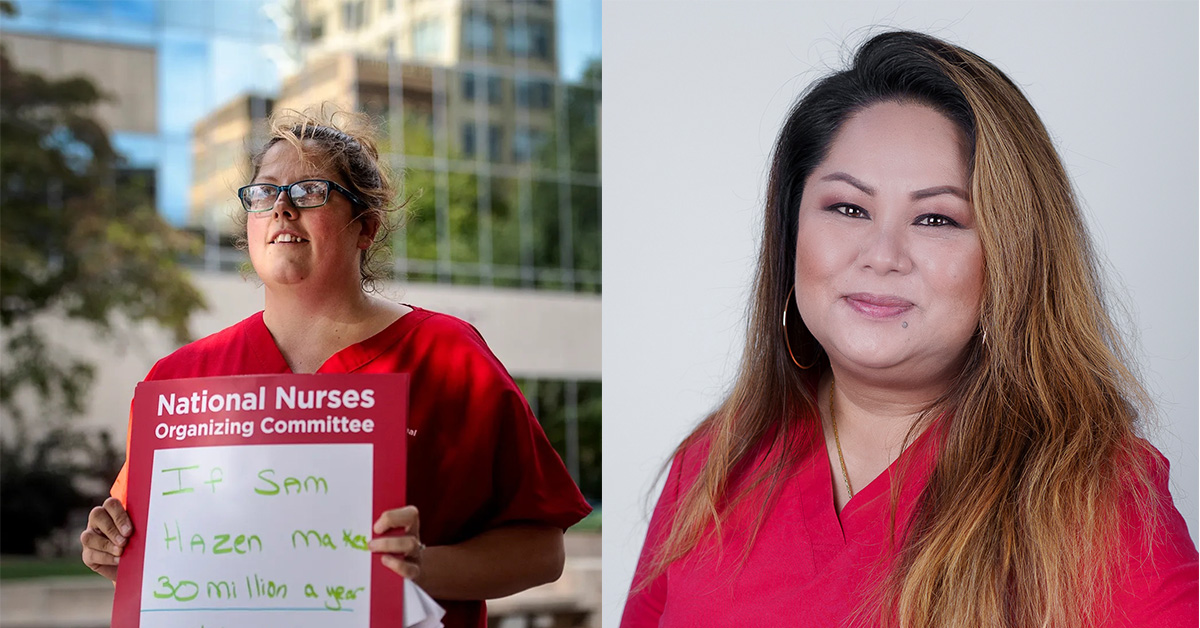The Heart of the Union

By Chuleenan Svetvilas
National Nurse magazine - Jan | Feb | March 2024 Issue
This is the first in a series of articles on the professional practice committee.
When Mission Hospital nurses in Asheville, N.C. voted to join National Nurses Organizing Committee (NNOC) in September 2020, Kerri Wilson, an RN in the telemetry unit, knew she wanted to be part of the professional practice committee (PPC). “When I learned about the different committees under the union, the PPC really stuck out to me as the leading committee to make changes in the hospital,” said Wilson. “Early on, I decided that I wanted to be a part of that.”
The PPC is a direct-care, RN-controlled committee negotiated into every contract, with the authority to document unsafe practices and the power to make real changes at the facility by making recommendations to hospital administration every month. The collective bargaining agreement (CBA) requires the chief nursing officer (CNO) or their designee to attend PPC meetings at the request of PPC members at a mutually agreed time. The CNO as well as any department heads could be required to attend meetings, particularly when nurses have issues that affect the entire facility.
Direct-care RNs elect representatives to serve on the committee, which meets in the hospital on paid time. The PPC tracks unsafe conditions through its own independent documentation system called the Assignment Despite Objection (ADO) form. PPC members meet monthly for four hours to discuss practice and staffing problems on various units across the hospital by analyzing the ADOs for trends and recurrent issues. The PPC meeting is also where nurses can develop projects for improvements to patient care and nursing practice. The PPC may also elect to report problems to the appropriate regulatory agencies.
Hospital administration is required by the collective bargaining agreement to send responses to the PPC’s recommendations in 30 days. When issues remain unresolved, the PPC can require the CNO or their designee to attend a PPC meeting or use the mandatory resolution process that requires administration to meet with the PPC in 14 days.
At Mission Hospital, where NNOC represents more than 1,650 RNs, each PPC position represents a different department — emergency department, operating room and perioperative, interventional radiology, catheterization laboratory, medical-surgical, wound care, IV team, case management, labor and delivery, intensive care unit, and telemetry. At Research Medical Center in Kansas City, Mo., a Level I trauma center with more than 560 nurses, there are eight PPC positions, with every unit represented via clinical clusters. For example, one PPC member represents medical-surgical, critical care, psychiatric, surgical and procedures, and women’s units. Research’s PPC, which has been in place since 2012, also has a staffing subcommittee that meets quarterly.
At Kaiser Permanente Fremont Medical Center in Fremont, Calif., there are three PPCs — one for inpatient RNs, another for outpatient RNs, and a third for nurse practitioners, with each member representing a different department. At Kaiser Fremont, where 600 nurses work, the inpatient and outpatient PPCs have more than 10 members, including alternates. “We used to have just one PPC, but inpatient issues are totally different from outpatient,” said Michelle Gutierrez Vo, RN and chair of the outpatient PPC at Kaiser Fremont, and a president of California Nurses Association/NNOC. “When we had one PPC, inpatient issues would dominate, and nothing would get done. By winning three separate PPCs in 2005, we have the proper space and time to identify issues to address and escalate.”
Gutierrez Vo has been involved with Kaiser Fremont’s PPC since she began working there 23 years ago. As a young nurse in the 2000s, she wanted to have more tools and more knowledge about how to protect her practice and her union contract and to be an advocate and be around similar minds. “The PPC is the most important tool we have at the facility level to identify issues to escalate — staffing, nursing practice, scope of practice, health and safety, or environmental issues,” said Gutierrez Vo. “This is the place where frontline nurses review ADOs and identify trends and red flags.”
“For a long, long time, we were segregated by department, but with our union and the PPC meeting every month, we are able to keep unified and know what’s happening across each department,” said Wilson. “Everyone can see that we’re all fighting together. The PPC is the heart and soul of the union in the facility.”
Stay tuned for the next article in the PPC series on what happens in PPC meetings.
Chuleenan Svetvilas is a communications specialist at National Nurses United.